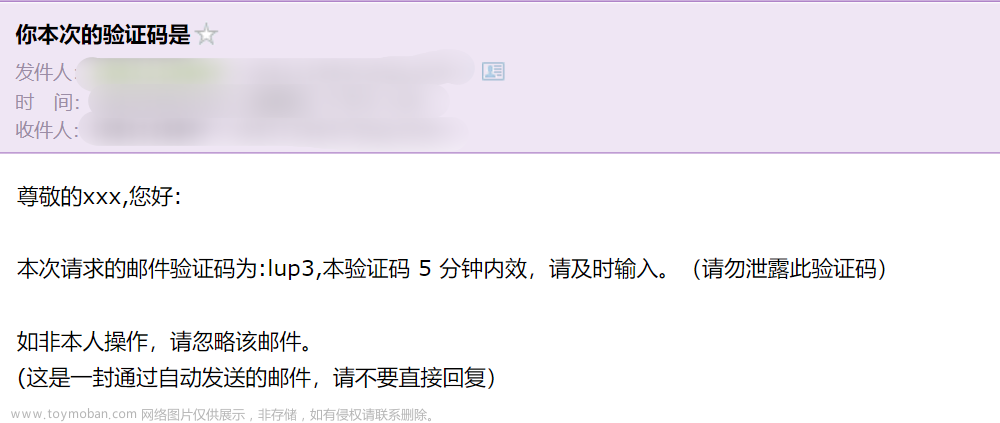前言
随着互联网的不断发展,验证码的作用越来越重要。作为常见的一种防范机制,验证码能有效避免机器人或者别有用心的人利用自动化程序进行注入攻击、暴力破解等恶意行为。在本文中,我们将讲解如何使用SpringBoot框架实现自定义验证码发送功能。您可根据自己应用场景的不同,对代码进行调整扩展。
环境和工具
- IDE:IntelliJ IDEA
- JDK:1.8
- SpringBoot版本:2.4.5.RELEASE
- Maven
实现思路
我们要实现的自定义验证码发送功能,其实就是在用户完成表单填写后,向用户发送一条验证码信息,以确定用户身份是否合法。在SpringBoot中,我们最好的方式就是借助Spring Framework自带的邮件发送工具实现。具体实现步骤如下:
- 定义邮箱模板和验证码生成方法
- 定义邮件发送服务
- 在控制层调用发送服务,并返回相应的结果信息
接下来,我们将逐步讲解具体步骤。
正文
1. 定义邮箱模板和验证码生成方法
在这里,我们先定义一个验证码生成工具类,通过调用Java自带的Random和StringBuilder类生成一个长度为6的纯数字验证码:
import java.util.Random;
/**
* 验证码生成工具类
*/
public class CodeUtil {
/**
* 生成随机验证码
*
* @return 验证码
*/
public static String generateCode() {
StringBuilder code = new StringBuilder();
Random random = new Random();
for (int i = 0; i < 6; i++) {
int num = random.nextInt(10);
code.append(num);
}
return code.toString();
}
}
接下来,我们需要定义发送邮件的模板,在这里我使用了Thymeleaf模板引擎,处理HTML模板:
<!DOCTYPE html>
<html lang="en" xmlns:th="http://www.thymeleaf.org">
<body>
<h1>验证码</h1>
<p th:text="'您的验证码是:' + ${captcha}" style="font-size: 20px;color: #3385ff;"></p>
</body>
</html>
2. 定义邮件发送服务
在这里,我们定义一个基于JavaMailSender的邮件发送服务:
import org.springframework.beans.factory.annotation.Autowired;
import org.springframework.core.io.FileSystemResource;
import org.springframework.mail.javamail.JavaMailSender;
import org.springframework.mail.javamail.MimeMessageHelper;
import org.springframework.stereotype.Service;
import javax.mail.MessagingException;
import javax.mail.internet.MimeMessage;
import java.io.File;
import java.io.UnsupportedEncodingException;
@Service
public class EmailServiceImpl implements EmailService {
@Autowired
private JavaMailSender javaMailSender;
/**
* 发送邮件
*
* @param to 收件人邮箱地址
* @param code 验证码
* @param subject 邮件主题
* @param template 邮件模板
* @param attachment 附件地址(可选)
*/
public void sendEmail(String to, String code, String subject, String template, String attachment)
throws MessagingException, UnsupportedEncodingException {
MimeMessage message = javaMailSender.createMimeMessage();
MimeMessageHelper helper = new MimeMessageHelper(message, true);
helper.setFrom("您的发件人邮箱地址", "您的昵称");
helper.setTo(to);
helper.setSubject(subject);
helper.setText(CodeUtil.generateCode(), true);
// 添加附件
if (attachment != null) {
FileSystemResource fileSystemResource = new FileSystemResource(new File(attachment));
helper.addAttachment("附件", fileSystemResource);
}
javaMailSender.send(message);
}
}
3. 在控制层调用发送服务,并返回相应的结果信息
最后一步,我们在控制层调用发送服务,并返回相应的结果信息。我们定义一个Controller,其中包含一个URL接口用于发送邮件。
import org.springframework.beans.factory.annotation.Autowired;
import org.springframework.mail.MailException;
import org.springframework.web.bind.annotation.*;
import javax.mail.MessagingException;
import java.io.UnsupportedEncodingException;
@RestController
public class EmailController {
@Autowired
private EmailService emailService;
/**
* 发送邮件
*
* @param to 邮件收件人
* @return 成功或失败提示信息
*/
@GetMapping("/sendEmail")
public String sendEmail(@RequestParam String to) {
try {
String code = CodeUtil.generateCode();
String subject = "验证码信息";
String template = "验证码模板";
String attachment = null;
emailService.sendEmail(to, code, subject, template, attachment);
return "验证码发送成功,请注意查收!";
} catch (MailException | MessagingException | UnsupportedEncodingException e) {
e.printStackTrace();
return "验证码发送失败,请重试!";
}
}
}
最后,我们需要配置邮件发送相关的信息,如邮件服务器地址、端口号、账号密码等信息。在 application.properties 或者 application.yml 中添加如下配置:文章来源:https://www.toymoban.com/news/detail-453335.html
spring.mail.host=smtp.163.com #SMTP 服务器地址
spring.mail.username=your_username@163.com #发送者邮箱账号
spring.mail.password=your_password #发送者邮箱密码
spring.mail.port=25 #SMTP服务器端口号
spring.mail.protocol=smtp #邮件协议,默认为smtp
spring.mail.properties.mail.smtp.auth=true #SMTP 登录认证
spring.mail.properties.mail.smtp.starttls.enable=true #如果是使用加密类的邮件协议,需要设置此项为true
总结
本文讲解了如何使用SpringBoot框架实现自定义验证码发送功能。通过验证码的使用,可以有效保障您应用的安全性。希望您在开发过程中能够参考以上内容,实现更加优秀的应用程序。文章来源地址https://www.toymoban.com/news/detail-453335.html
参考资料
- Spring Framework Docs
- Thymeleaf Docs
- JavaMailSender Docs
到了这里,关于SpringBoot实现发送自定义验证码的文章就介绍完了。如果您还想了解更多内容,请在右上角搜索TOY模板网以前的文章或继续浏览下面的相关文章,希望大家以后多多支持TOY模板网!












